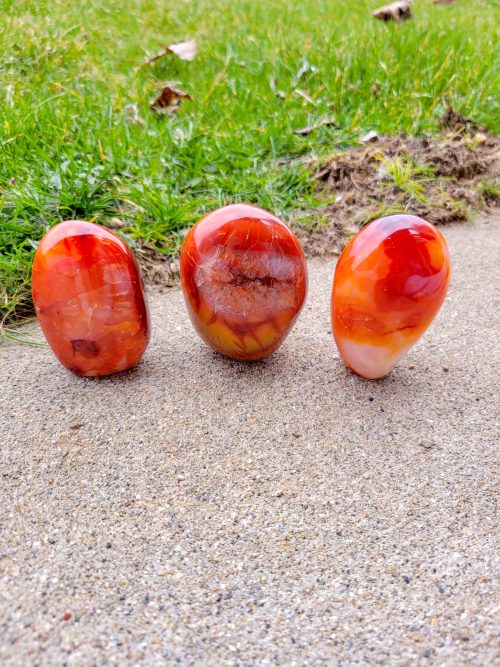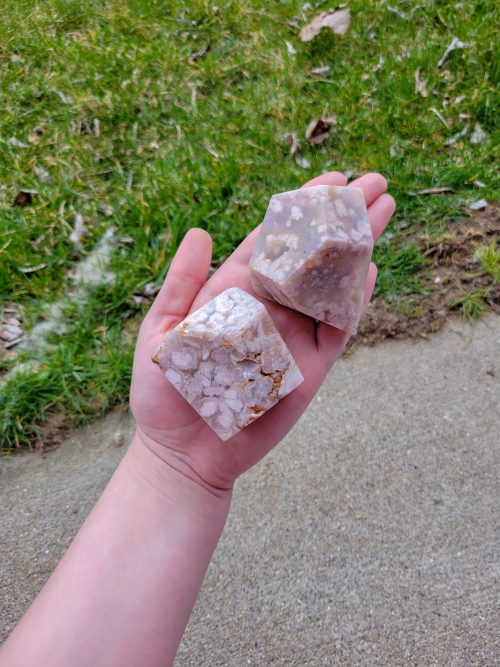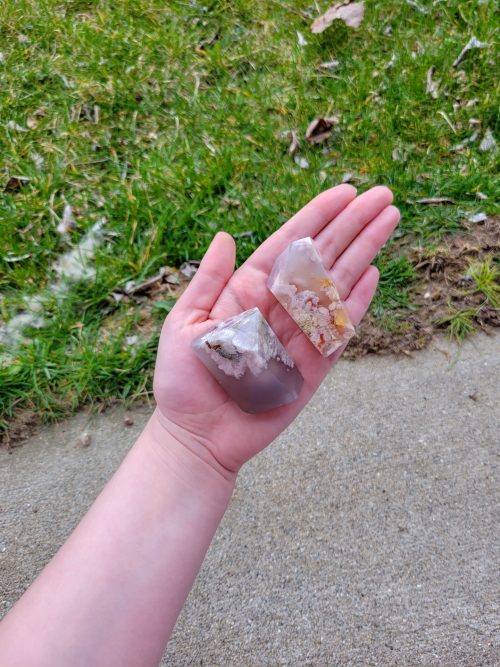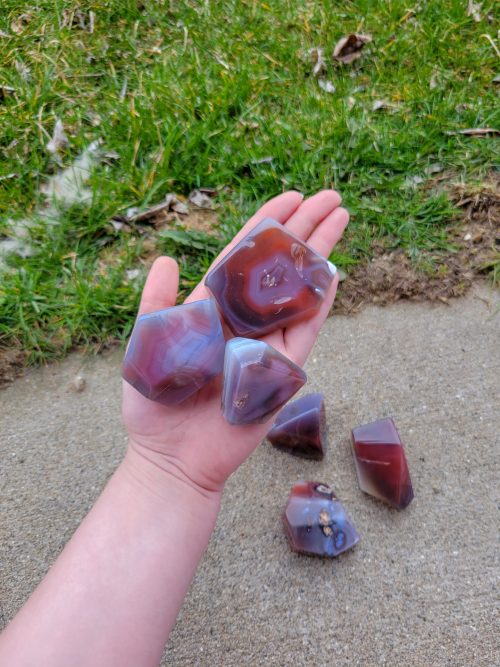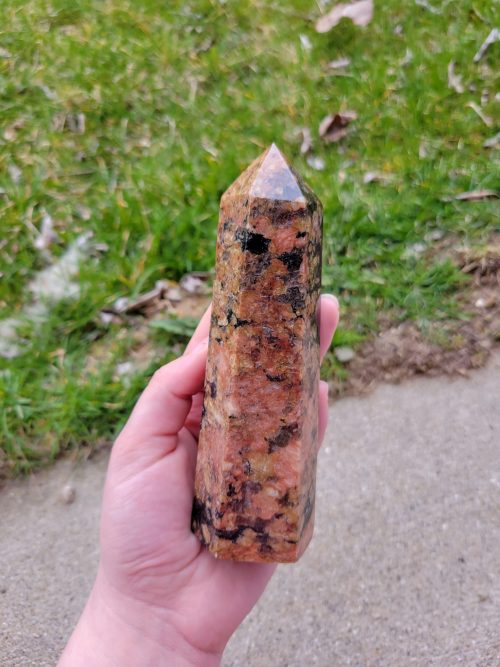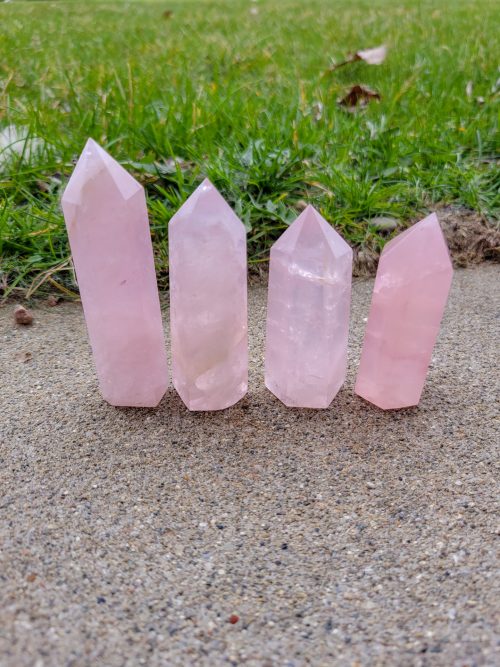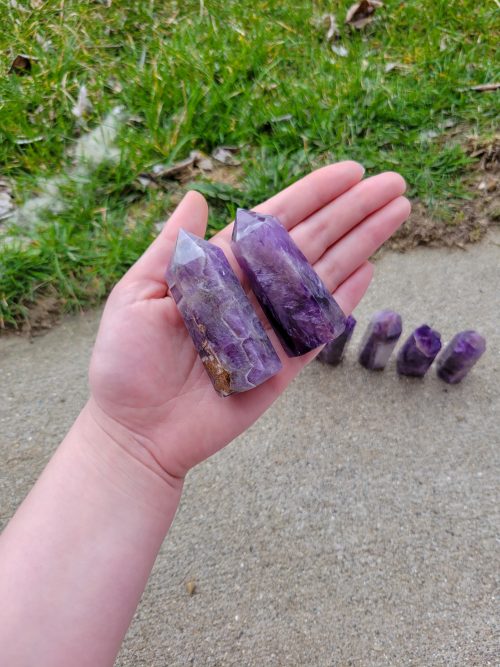-
5cm x 4cm x 7.5cm Carnelian is a part of the Chalcedony family. It is formed when two silica minerals with different crystal structures grow together such as quartz and moganite. The firey orange and red colors come from iron oxides in the mineral. Carnelian can be found in Brazil, India, and Uruguay. ***Due to natural variations in stones, the appearance will vary***
-
6cm Wide Flower agate gets its name from the flower-like formations within the crystal's body. These crystals are volcanic rocks that are mainly composed of chalcedony and quartz. These crystals can vary in color; from pink to a dark grey/purple. Recently discovered in Madagascar, these crystals are believed to go back to 2000 BC. ***Due to natural variations in stones, the appearance will vary***
-
5cm Wide Flower agate gets its name from the flower-like formations within the crystal's body. These crystals are volcanic rocks that are mainly composed of chalcedony and quartz. These crystals can vary in color; from pink to a dark grey/purple. Recently discovered in Madagascar, these crystals are believed to go back to 2000 BC. ***Due to natural variations in stones, the appearance will vary***
-
5cm x 5cm x 6cm Agate is a translucent form of microcrystalline quartz. These crystals form inside of igneous rocks over a long period of time and get their banding from years of siliceous groundwater building up in the cavities of these rocks. What makes this mineral so beautiful and unique is that the color variations and banding patterns are completely dependent on the environmental factors around them. This makes it so that every formation is different and there are no two formations that are the same! ***Due to natural variations in stones, the appearance will vary***
-
6cm x 6.5cm x 1.5cm Agate is a translucent form of microcrystalline quartz. These crystals form inside of igneous rocks over a long period of time and get their banding from years of siliceous groundwater building up in the cavities of these rocks. What makes this mineral so beautiful and unique is that the color variations and banding patterns are completely dependent on the environmental factors around them. This makes it so that every formation is different and there are no two formations that are the same! ***Due to natural variations in stones, the appearance will vary***
-
5.5cm x 4.5cm x 2cm Agate is a translucent form of microcrystalline quartz. These crystals form inside of igneous rocks over a long period of time and get their banding from years of siliceous groundwater building up in the cavities of these rocks. What makes this mineral so beautiful and unique is that the color variations and banding patterns are completely dependent on the environmental factors around them. This makes it so that every formation is different and there are no two formations that are the same! ***Due to natural variations in stones, the appearance will vary***
-
6cm x 3.5cm x 2.5cm Agate is a translucent form of microcrystalline quartz. These crystals form inside of igneous rocks over a long period of time and get their banding from years of siliceous groundwater building up in the cavities of these rocks. What makes this mineral so beautiful and unique is that the color variations and banding patterns are completely dependent on the environmental factors around them. This makes it so that every formation is different and there are no two formations that are the same! ***Due to natural variations in stones, the appearance will vary***
-
5.5cm x 4cm x 4.5cm Agate is a translucent form of microcrystalline quartz. These crystals form inside of igneous rocks over a long period of time and get their banding from years of siliceous groundwater building up in the cavities of these rocks. What makes this mineral so beautiful and unique is that the color variations and banding patterns are completely dependent on the environmental factors around them. This makes it so that every formation is different and there are no two formations that are the same! ***Due to natural variations in stones, the appearance will vary***
-
4.5cm x 4cm x 2.5cm Agate is a translucent form of microcrystalline quartz. These crystals form inside of igneous rocks over a long period of time and get their banding from years of siliceous groundwater building up in the cavities of these rocks. What makes this mineral so beautiful and unique is that the color variations and banding patterns are completely dependent on the environmental factors around them. This makes it so that every formation is different and there are no two formations that are the same! ***Due to natural variations in stones, the appearance will vary***
-
15.5cm Tall Jasper is an opaque and impure variety of silicon dioxide. The name 'jasper' originates from the Greek word for 'spotted stone' which refers to its typical multi-colored, striped, spotted or flamed appearance. Jasper can come in just about any color depending on the sediments of the original mineral. This mineral is mostly found in India, Russia, Egypt, Madagascar, and Australia. ***Due to natural variations in stones, the appearance will vary***
-
8.5cm - 9.5cm Tall Rose Quartz is an anhedral crystal. It is found in the cores of pegmatites and gets its color from microscopic inclusions of a pink variety of the mineral dumortierite . Rose Quartz is naturally a pink hue but can have more hues of grey/purple or red. This mineral Earth's can be found in many places including South Africa, Madagascar, and Brazil. ***Due to natural variations in stones, the appearance will vary***
-
7.5cm Tall Dream amethyst (also known as Chevron Amethyst) is a natural mineral formed when amethyst and white quartz fuse together while cooling down off after a volcanic eruption. The amethyst that fuses to the white quartz creates the chevron-like shapes in the crystals. The main areas Dream Amethyst can be found is Brazil, Namibia, and Morocco. ***Due to natural variations in stones, the appearance will vary***

